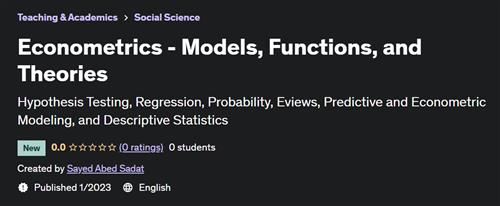Solving Questions of Statistics and Econometrics

Published 1/2023
Created by Sayed Abed Sadat
MP4 | Video: h264, 1280x720 | Audio: AAC, 44.1 KHz, 2 Ch
Genre: eLearning | Language: English | Duration: 5 Lectures ( 54m ) | Size: 222 MB
Master in Solving Statistical and Econometrics Questions
What you'll learn
Understanding theories of statistics
Solving complex questions of statistics
Analyzing data and visualizing
Introduction to working with econometric data and models
Requirements
Basic understanding of mathemtaics
Description
Statistics:Statistics is a mathematical body of science that pertains to the collection, analysis, interpretation or explanation, and presentation of data, or as a branch of mathematics. Some consider statistics to be a distinct mathematical science rather than a branch of mathematics. While many scientific investigations make use of data, statistics is concerned with the use of data in the context of uncertainty and decision-making in the face of uncertainty.In applying statistics to a problem, it is common practice to start with a population or process to be studied. Populations can be diverse topics such as "all people living in a country" or "every atom composing a crystal". Ideally, statisticians compile data about the entire population (an operation called census). This may be organized by governmental statistical institutes. Descriptive statistics can be used to summarize the population data. Numerical descriptors include mean and standard deviation for continuous data (like income), while frequency and percentage are more useful in terms of describing categorical data (like education).When a census is not feasible, a chosen subset of the population called a sample is studied. Once a sample that is representative of the population is determined, data is collected for the sample members in an observational or experimental setting. Again, descriptive statistics can be used to summarize the sample data. However, drawing the sample contains an element of randomness; hence, the numerical descriptors from the sample are also prone to uncertainty. To draw meaningful conclusions about the entire population, inferential statistics is needed. It uses patterns in the sample data to draw inferences about the population represented while accounting for randomness. These inferences may take the form of answering yes/no questions about the data (hypothesis testing), estimating numerical characteristics of the data (estimation), describing associations within the data (correlation), and modeling relationships within the data (for example, using regression analysis). Inference can extend to forecasting, prediction, and estimation of unobserved values either in or associated with the population being studied. It can include extrapolation and interpolation of time series or spatial data, and data mining.Econometrics:conometrics is an application of statistical methods to economic data in order to give empirical content to economic relationships. More precisely, it is "the quantitative analysis of actual economic phenomena based on the concurrent development of theory and observation, related by appropriate methods of inference
Who this course is for
University students
Data analysts
Statistitians
Homepage
https://www.udemy.com/course/econometrics-and-statistics/Links are Interchangeable - No Password - Single Extraction




